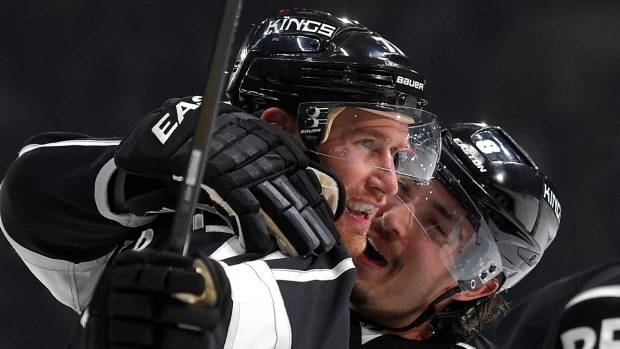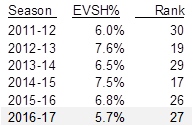Nov 8, 2016
Kings’ system curbs team’s goal-scoring rate
Darryl Sutter’s team has mastered the art of possession, Travis Yost writes, sacrificing team shooting percentage along the way.
By Travis Yost

The Los Angeles Kings cannot buy a goal.
In some ways, it’s a continuance of what we’ve seen from Darryl Sutter’s team in the past. His Kings have never been blessed with overwhelming individual offensive talent, instead relying on sustaining significant offensive zone pressure to beat teams with an attack best described as death by a thousand paper cuts.
This hasn’t changed for years. We know the Kings are going to be a sub-par shooting team that will more than offset that negative by generating close to six shots for every four shots against. When you run those kinds of differentials you not only increase the likelihood of scoring over a single game or season, you also take an unbelievable amount of pressure off of your defence.
This year, at least on the surface, looks like another chapter in this story. The Kings are the league leaders in 5-on-5 Corsi% at 56 per cent, and are near the bottom in team shooting percentage at 5.7 per cent. Their Corsi% this year is almost identical to the Corsi% they have posted over the last five years (55.9 per cent), so I’m reasonably confident the impressive territorial control will continue for the rest of the 2016-17 season.
Shooting percentage remains a different animal and an interesting topic of discussion. We know that team-level shooting percentage regresses heavily toward the league average over an 82-game sample, which means that our best guess for most teams shooting talent this year is just about the same number – 7.8 per cent. Thus, if you are a team like the New York Rangers (12.4 per cent) or Vancouver Canucks (4.2 per cent) this year, our best guess over the next 70 games would still be about 7.8 per cent. This simple concept of regression is tried and true, and in most every instance it’s a better guess at future outcome than alternative methodologies.
The Kings may offer an interesting deviation from the norm on this front, though. Ever since the Kings entered the fray as possession dynamos, they have seen their shooting percentage consistently fall below league averages. Though it’s bounced between substandard and abysmal, we have yet to see a season where they breach league average.

Could it be merely coincidence that Los Angeles has run out six straight seasons of poor shooting percentage? Possibly, though the chance of that happening is about 1.6 per cent. Could it be that Los Angeles’ system, which punishes teams through a heavy dump-and-chase style of hockey, lends itself to controlling the run of play and also poorer-than-expected shooting talent? After almost six years of observing as much, I think it’s time we really start giving this theory some credence.
One of the ways we can tease out whether there’s something real going on here is to look at the percentage of shots generated by a given team that would be considered dangerous. Using Corsica’s methodology, here’s where Los Angeles has ranked against the league over the same six-year interval:

So, this falls in line with what we would expect – Los Angeles’ middling shooting percentage over the last six years is strikingly similar to their relative inability to generate dangerous shots. This is part of the reason I struggle with the notion that it’s exclusively coincidental or random that the Kings post substandard team shooting percentages. Their system, for better or for worse, seems to drive conversion rates into the ground.
I think it’s more than fair to point out that there are a couple of obvious offsetting benefits to Los Angeles’ system. The obvious one is that they have, to some degree, mastered the art of controlling possession. Even though they shoot at lowly rates, they still own about six of every 10 shots taken in any given game. It’s a lot to ask of an opponent to try and overcome those odds, especially with how many goals are scored through rebounds, ricochets, and general chaos. Not every goal is a snipe from the dot.
The second piece is that there’s a very real benefit on the defensive end. The Kings’ have been known for possessing one of the league’s best defensive units, and while the percentage of dangerous shots they generate offensively is low, the percentage of dangerous shots they concede is also low. In fact, their league ranks defensively on this front in the last five years are: 8th, 1st, 12th, 9th, and 2nd in 2016-17. Add that to the fact that they just don’t concede a lot of shots to begin with, and you have a team that’s very difficult to score on.
What’s the takeaway here? Well, unless something systemically changes (or the team goes through major roster/coaching overhaul), the Kings will continue to be a low-scoring, low-goals-against team. Their strategy, intentional or otherwise, is to pile shot volumes on teams and win at the margins. That strategy has worked for many years. But, we should be cautious about expecting goal-scoring corrections for this team like we would most others – their system does not lend itself to the posting of great conversion rates.


